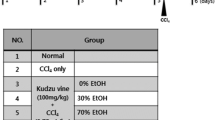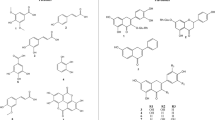Abstract
Objective
To investigate the mechanism of Radix Kansui (RK) stir-fried with vinegar (VRK) decreased hepatotoxicity in mice.
Methods
According to a random number table, 40 mice were randomly divided into negative control group (0.5% carboxymethylcellulose sodium, 20 mL/kg), positive control group (0.1% mixture of carbon tetrachloride in soybean oil, 20 mL/kg), RK group (the ethyl acetate extracts of RK, 250 g crude drug/kg) and VRK group (the ethyl acetate extracts of VRK, 250 g crude drug/kg) with 10 mice per group. All mice were administered orally by gavage daily for 7 continuous days. The morphology of liver tissues was examined to assess the liver injury by a transmission electron microscope. Hepatocyte apoptosis in vivo was determined by terminal deoxynucleotidyltransferase-mediated dUTP-biotin nickend labeling (TUNEL) assay. Immunohistochemical technique was adopted to detect the expression of particular antiapoptotic and proapoptotic proteins in the mitochondrial pathways, including B-cell lymphoma (Bcl-2) and caspase-3, as well as the expression of inflammatory mediators, including nuclear factor kappa B (NF- κ B) and intercellular adhesion molecule-1 (ICAM-1).
Results
Liver injury and hepatocyte apoptosis were observed in RK mice, and the liver injury were significantly reduced in VRK-treated mice. In immunohistochemistry study, compared with the negative control group, RK inhibited dramatically the Bcl-2 protein expression and significantly increased the expression of caspase-3, NF- κ B and ICAM-1 (all P<0.01). Compared with the RK group, VRK group induced significant increase on Bcl-2 protein expression, and decreased the caspase-3, NF- κ B and ICAM-1 protein expression (P<0.05 or P<0.01).
Conclusion
The mechanism of reduced hepatotoxicity of VRK may be associated with the reduced inflammation, regulation of antiapoptotic and proapoptotic mediators in the mitochondrial pathway.
Similar content being viewed by others
References
Chinese Pharmacopoeia Commission, ed. Pharmacopoeia of the People’s Republic of China Volume I. Bejing: China Medical Science Press: 2015:88.
Shen J, Kai J, Tang Y, Zhang L, Su S, Duan JA. The chemical and biological properties of Euphorbia kansui. Am J Chin Med 2016;44:253–273.
Zhao XY, Cai X, Hu ZH. Research progress on biology, chemical constituents in Euphorbia kansui, and their pharmacological effects. Chin Tradit Herb Drugs (Chin) 2014;45:3029–3033.
Liu Q, Li W, Huang L, Asada Y, Morris-Natschke SL, Chen CH, et al. Identification, structural modification, and dichotomous effects on human immunodeficiency virus type 1 (HIV-1) replication of ingenane esters from Euphorbia kansui. Eur J Med Chem 2018;156:618–627.
Wang P, Lu P, Qu X, Shen Y, Zeng H, Zhu X, et al. Reactivation of HIV-1 from latency by an ingenol derivative from Euphorbia kansui. Sci Rep 2017;7:9451.
Zhang Q, Zhou QR, Lou JW, Chen PD, Yao WF, Tao WW, et al. Chemical constituents from Euphorbia kansui. Molecules 2017;22:2176.
Hou J J, Shen Y, Yang Z, Fang L, Cai LY, Yao S, et al. Anti-roliferation activity of terpenoids isolated from Euphorbia kansui in human cancer cells and their structure-activity relationship. Chin J Nat Med (Chin) 2017;15:766–774.
Ma H, Yang S, Lu H, Zhang Y. Bioassay-guided separation of anti-tumor components from Euphorbia kansui by means of two-dimensional preparative high performance liquid chromatography and real-time cell analysis. Anal Sci 2016;32:581–586.
Fei DQ, Dong LL, Qi FM, Fan GX, Li HH, Li ZY, et al. Euphorikanin A, a diterpenoid lactone with a fused 5/6/7/3 ring system from Euphorbia kansui. Org Lett 2016;18:2844–2847.
Liu M, Zhang W, Wang G, Song X, Zhao X, Wang X, et al. 13-oxyingenol dodecanoate, a cytotoxic ingenol derivative, induces mitochondrial apoptosis and caspase-dependent Akt decrease in K562 cells. Tumor Biol 2016;37:6227–6238.
Kim YM, Ahn J, Chae HS, Choi YH, Kim J, Chin YW. Two new lathyrane-type diterpenoid glycosides with IL-6 production inhibitory activity from the roots of Euphorbia kansui. Bioorg Med Chem Lett 2018;28:1207–1210.
Oh S, Oh HW, Lee HR, Yoon SY, Oh SR, Ko YE, et al. Ingenane-type diterpene compounds from Euphorbia kansui modulate IFN- γ production through NF-κB activation. J Sci Food Agric 2016;96:2635–2640.
Lee JW, Jin Q, Jang H, Lee D, Han SB, Kim Y, et al. Jatrophane and ingenane-type diterpenoids from Euphorbia kansui inhibit the LPS-induced NO production in RAW 264.7 cells. Bioorg Med Chem Lett 2016;26:3351–3354.
Gao J, Gao L, Zhang L, Yao W, Cao Y, Bao B, et al. 3-O-(2′E,4′Z-decadienoyl)-20-O-acetylingenol induces apoptosis in intestinal epithelial cells of rats via mitochondrial pathway. J Ethnopharmacol 2015;174:331–338.
Cheng F, Yang Y, Zhang L, Cao Y, Yao W, Tang Y, et al. A natural triterpene derivative from Euphorbia kansui inhibits cell proliferation and induces apoptosis against rat intestinal epithelioid cell line in vitro. Int J Mol Sci 2015;16:18956–18975.
Yan X, Zhang L, Cao Y, Yao W, Tang Y, Ding A. An ingenol derived from Euphorbia kansui induces hepatocyte cytotoxicity by triggering G0/G1 cell cycle arrest and regulating the mitochondrial apoptosis pathway in vitro. Molecules 2016;21:813.
Zhang Q, Cao LL, Lou JW, Zhang L, Ding AW. Effect of processing with vinegar on toxicity of Kansui Radix in normal and cancerous ascites model rats. Chin J Exper Tradit Med Form (Chin) 2016;22:1–6.
Gao L, Yan XJ, Li ZJ, Yang YJ, Zhang L, Ding AW. Gastrointestinal toxicity attenuation of Kansui Radix stir-baked with vinegar by reducing oxidative injury in mice. Chin J Exper Tradit Med Formul (Chin) 2013;19:257–260.
Zhang L, Gao L, Yan XJ, Cao YD, Ding AW. Effect of Kansui Radix prepared by different processes on LO2 cell cycle and apoptosis. Chin J Chin Mater Med (Chin) 2013;38:825–830.
Yang Z, Hou JJ, Qi P, Yang M, Yan BP, Bi QR, et al. Colon-derived uremic biomarkers induced by the acute toxicity of Kansui Radix: a metabolomics study of rat plasma and intestinal contents by UPLC-QTOF-MS(E). J Chromatogr B Analyt Technol Biomed Life Sci 2016;1026:193–203.
Tang B, Ding J, Yang Y, Wu F, Song F. Systems biochemical responses of rats to Kansui and vinegar-processed Kansui exposure by integrated metabonomics. J Ethnopharmacol 2014;153:511–520.
Zhang Q, Zhang KC, Lou JW, Guo SC, Zhang Y, Yao WF, et al. Simultaneous quantification of twelve compounds in ethyl acetate extracts of Euphorbia kansui before and after fry-baked with vinegar by UPLC-MS/MS and its toxic effect on zebrafish. J Pharm Biomed Anal 2018;155:169–176.
Yan X, Zhang L, Guo J, Cao Y, Shang E, Tang Y, et al. Processing of Kansui roots stir-baked with vinegar reduces Kansui-induced hepatocyte cytotoxicity by decreasing the contents of toxic terpenoids and regulating the cell apoptosis pathway. Molecules 2014;19:7237–7254.
Huang HY, Shu XY, Ding AW, Zhang L. Experimental study on purgative activity and acute toxicity of ethanol extracts from different polar parts of Radix Kansui and vinegar-preparing Radix Kansui. Chin Pharmac (Chin) 2008;17:3–4.
Shu X, Jiang XW, Cheng BC, Ma SC, Chen GY, Yu ZL. Ultraperformance liquid chromatography-quadrupole/time-of-flight mass spectrometry analysis of the impact of processing on toxic components of Kansui Radix. BMC Complement Altern Med 2016;16:73.
Cao L, Quan XB, Zeng WJ, Yang XO, Wang MJ. Mechanism of hepatocyte apoptosis. J Cell Death 2016;9:19–29.
Redza-Dutordoir M, Averill-Bates DA. Activation of apoptosis signalling pathways by reactive oxygen species. Biochim Biophys Acta 2016;1863:2977–2992.
Czabotar PE, Lessene G, Strasser A, Adams JM. Control of apoptosis by the Bcl-2 protein family: implications for physiology and therapy. Nat Rev Mol Cell Biol 2014;15:49–63.
Kiraz Y, Adan A, Kartal Yandim M, Baran Y. Major apoptotic mechanisms and genes involved in apoptosis. Tumor Biol 2016;37:8471–8486.
Juraver-Geslin HA, Durand BC. Early development of the neural plate: new roles for apoptosis and for one of its main effectors caspase-3. Genesis 2015;53:203–224.
Savitskaya MA, Onishchenko GE. Mechanisms of apoptosis. Biochemistry (Mosc) 2015;80:1393–1405.
Czabotar PE, Lessene G, Strasser A, Adams JM. Control of apoptosis by the Bcl-2 protein family: implications for physiology and therapy. Nat Rev Mol Cell Biol 2014;15:49–63.
Shoda LK, Battista C, Siler SQ, Pisetsky DS, Watkins PB, Howell BA. Mechanistic modelling of drug-induced liver injury: investigating the role of innate immune responses. Gene Regul Syst Bio 2017;11:1–22.
Iorga A, Dara L, Kaplowitz N. Drug-induced liver injury: cascade of events leading to cell death, apoptosis or necrosis. Int J Mol Sci 2017;18:1018.
Zhang Q, Lenardo MJ, Baltimore D. 30 years of NF- κ B: a blossoming of relevance to human pathobiology. Cell 2017;168:37–57.
Ramos TN, Bullard DC, Barnum SR. ICAM-1: isoforms and phenotypes. J Immunol 2014;192:4469–4474.
Yang YJ, Yan XJ, Zhang L, Ding AW. Study on reducing mechanism of hepatotoxicity induced by ethyl acetate fractions of Kansui Radix stir-baked with vinegar in mice. Chin J Chin Mater Med (Chin) 2013;12:1966–1971.
Acknowledgment
The authors are very grateful to all members of Level-3 Laboratory for Chinese Medicine Chemistry of State Administration of Traditional Chinese Medicine of China for their personnel and equipment support.
Author information
Authors and Affiliations
Contributions
Bao BH and Ding AW conceived and designed the experiments. Yan XJ and Cao YD performed the experiments. Chen PD, Yao WF and Shan MQ analyzed the data. Bao BH and Cheng FF wrote and revised the manuscript. All authors read and approved the final version of the manuscript.
Corresponding author
Ethics declarations
The authors declared no conflict of interest.
Additional information
Supported by the National Natural Science Foundation of China (No. 81673599, 81503250, and 21705081), the Natural Science Research Program of Jiangsu Higher Education Institutions (No.15KJB360009), the Natural Science Foundation of Jiangsu Province (No. BK20161037), the Project Foundation of the Priority Academic Program Development of Jiangsu Higher Education Institutions (No. PAPD-2014), and Six Talent Peaks Program of Jiangsu Province (No. 2016-YY-026)
Supported by the National Natural Science Foundation of China (No. 81673599, 81503250, and 21705081), the Natural Science Research Program of Jiangsu Higher Education Institutions (No.15KJB360009), the Natural Science Foundation of Jiangsu Province (No. BK20161037), the Project Foundation of the Priority Academic Program Development of Jiangsu Higher Education Institutions (No. PAPD-2014), and Six Talent Peaks Program of Jiangsu Province (No. 2016-YY-026)
Rights and permissions
About this article
Cite this article
Bao, Bh., Yan, Xj., Cao, Yd. et al. Radix Kansui Stir-Fried with Vinegar Reduces Radix Kansui-Related Hepatotoxicity in Mice via Mitochondrial Pathway. Chin. J. Integr. Med. 27, 192–197 (2021). https://doi.org/10.1007/s11655-019-3023-x
Accepted:
Published:
Issue Date:
DOI: https://doi.org/10.1007/s11655-019-3023-x




